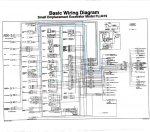Do you have any more insight as to why a faulty regulator would lead to this issue of no dash power?
I have the same issue as Jon did but I do have power to the high beam indicator and the charging control light comes on. My harness is uncut/not-rat eaten so I've got that going for me. No instrument gauges work including instrument lights in the combination gauge. The dash indicator lights for PTO, P-brake, etc do function. I've pulled the dash and traced power through the ignition switch to the combination instrument gauge which is a good 24.7v, the wire ohm'd good as well. The voltmeter gauge shows nothing. I'm at a loss unless this alternator regulator is to blame. Is there any way to test it?
Hi Fuzzy,
Have you had in luck in tracking down the problem? I have gotten busy with other stuff, but I believe that I have a similar problem because may of my panel lights, and the gauges don't function. There are some (?? unexpected at least for me ??) relationships in how the components are wired that likely play a part. Here is a bit of my saga so far.
The problem set out to solve was the starter button not working. The first Issue I found was the heavy 4A wire 11 (position 1 on the 8 wire plug) coming off of the positive terminal on the starter had gotten hot at some time and the whole plug was in bad shape and the wire was unplugged. After fixing that, all of the gauges pegged out at their highest reading on the instrument cluster, but the starter button still did nothing.


Tracing backward from the starter button, wire 211 goes to the "default on" (terminal 87a) on the no repeat starter relay (refer to diagram). The no repeat starter relay was powered on breaking the default on connection to the starter button. The relay (terminal 86) was getting powered by wire 342 which connects to wire 34 which comes from the instrument cluster. The instrument cluster was powered from the key switch line 37. After disconnecting line 37 from the key switch the starter button finally worked so the problem was that 34/342 was grounding through the relay I reconnected line 37 from the key switch, and traced wire 342/34 after the plug to where it connects to the alternator. I pulled the alternator and discovered that someone had left it in a sorry state. While I had the alternator off I tested it. according to TM-5-2420-224-34
Test stator (5) as follows (note each reading):
[*=1]Connect one ohmmeter lead to bare metal surface on stator lamination (6).
[*=1]Connect other lead to each of four stator (5) terminals.
High resistance reading should be obtained each time. If there is no reading or ohmmeter reads zero, replace stator (5).
When I tested it there was infinite resistance between the terminals and the stator lamination. So I found a good deal on an alternator off of E-Bay, put everything back together the way it should be, and now the starter button works, the gauges are at zero but do not work, the tach controlled by the alternator works, the alternator gauge seems to react, and some of the indicator lights work the turn signal indicator lights don't work, I think the oil pressure low indicator light is coming on (even though I don't think it has low oil pressure). Bottom line, I think I started further behind you but now I am at a similar state as you with the gauges and panel lights. I suspect it is a grounding issue but that has yet to be proven. If you have gained any insight since your original post I would love to hear from you. I don't think it is the voltage regulator, but I might swap the original one back in to the new alternator to see if that makes a difference.
One of the first things I did (and I think it was a good first step) was to dis-assemble both fuse panels and wiring harness plugs, clean all contacts with vinegar/salt bath followed by a good scrub with a copper wire brush and a baking soda bath to clean and neutralize the vinegar acid. After reassembly a lot of things seemed to work better, exterior lights and turn signals windshield wiper, horn etc. but that did not effect the panel lights and gauges.






